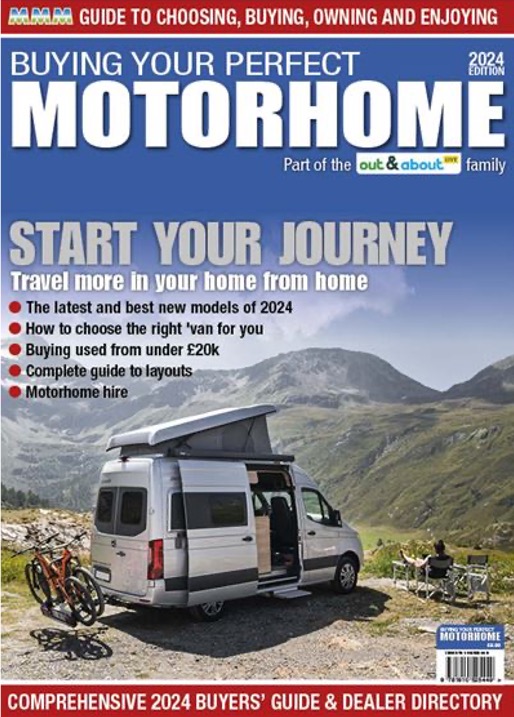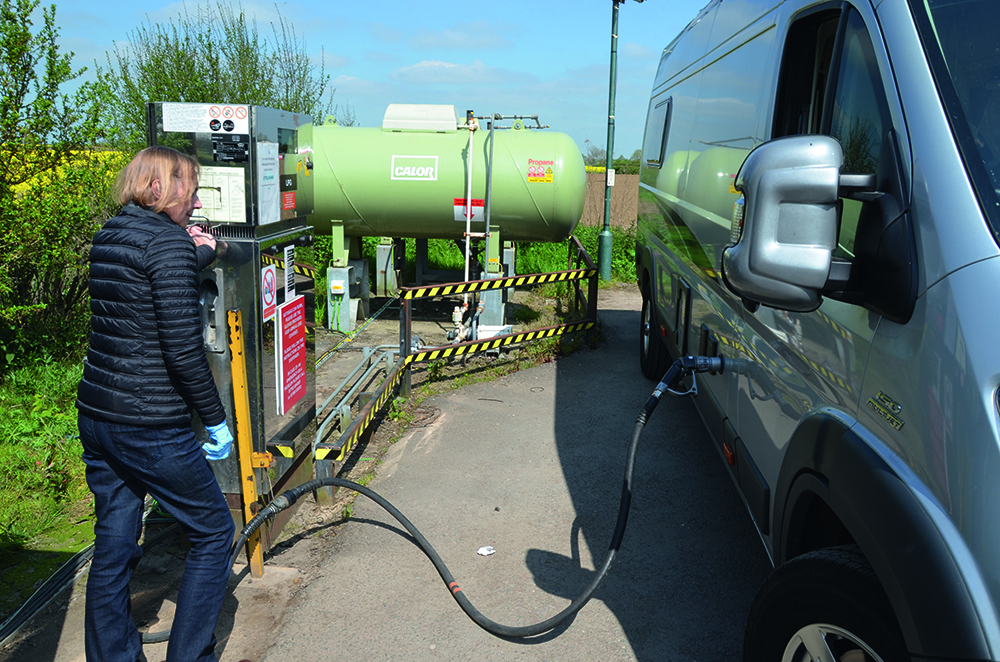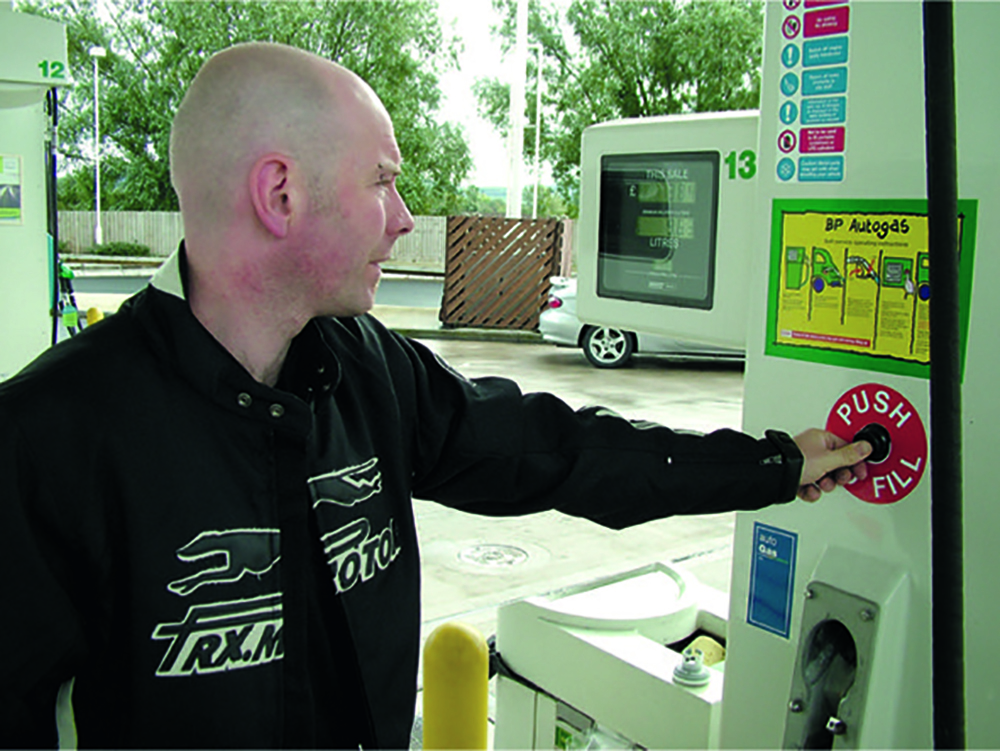Motorhome advice: Gas tanks or refillable cylinders?
Until about 15 years ago, your options for gas were limited to using exchangeable gas cylinders stored in a purpose-made locker. Now it’s possible to have a direct replacement of your exchangeable bottles with similar-sized refillable cylinders or install a bulk tank fixed to the underneath of your motorhome or campervan.
Calor cylinders
For the majority of users of exchange cylinders, the choice is Calor. Other companies supply exchange cylinders, but Calor’s the only company with a truly comprehensive national network of outlets. Calor cylinders are also available on just about every large campsite in the UK.
The only rival for coverage is Campingaz cylinders but, with the largest (907) cylinder containing 2.75kg of butane gas, it has only limited appeal for motorhomers. Also, butane performs poorly in low temperatures compared to propane. Therefore, the Calor option is an excellent one for motorhomers who tour in the UK, but the cost of refills does cause concern.
Cost aside, the other disadvantage of Calor cylinders is the lack of availability abroad. If you’ve room in your gas locker for an extra Campingaz cylinder, this could help as Campingaz operates a Europe-wide exchange service, but a 907 refill costs about £28. Exchangeable cylinders are seen as expensive, but this has to be viewed in the context of the large costs associated with filling and distribution. Plus, gas companies are responsible for inspection and refurbishment of cylinders.
Refillable cylinders
For many years, refillable cylinders were frowned upon, often for good safety reasons. Now there are several manufacturers that have refillable cylinders with excellent safety features, making them a viable option. This option enables users to refill cylinders at service stations with autogas for less than the equivalent exchangeable refill. Autogas is LPG (liquified petroleum gas) sold for vehicles converted to run on LPG and in the UK this is largely propane gas.
There is still reticence among some fuel stations regarding refilling such cylinders, which stems from guidance issued by UKLPG, the British trade association for the LPG industry. The current advice from UKLPG is, “free-standing LPG cylinders should not be filled at LPG refuelling facilities by customers or untrained personnel.” Because of this, most refillable cylinder suppliers offer the option of a remote external filling point for fitting in the external bodywork of the motorhome. Generally, filling stations accept refilling when it is undertaken in exactly the same way as refilling a LPG-powered vehicle.
LPG is widely available throughout Europe and listings of LPG stations at home and abroad are available. As you travel south in Europe you may find auto LPG contains a greater proportion of butane but, providing you’ve a 30mb regulator system, your appliances should function normally.
Gaslow was one of the early pioneers in safe refillable gas systems. As well as its systems filled remotely, it also offers a direct fill cylinder, whereby the gas dispensing nozzle is affixed directly to the cylinder. As many filling stations will deny use of their forecourt for this style of filling, Gaslow publishes a list of filling stations that permit such refilling on their forecourts.
Get MMM for just £29.99 a month!

MMM is Britain’s best-selling motorhome magazine and it has been for over 55 years. Each four-weekly issue is packed with the best motorhome travel features, genuine reader reviews of campsites, in-depth motorhome reviews, plus the latest technical advice, buying tips and much more.
MMM’s fully searchable digital library gives you access to the latest issues, plus every edition of MMM since January 2012.
Fixed tanks
In recent years, more and more gas tanks for motorhomes have been fixed underneath the vehicle. Some early examples of gas tanks fitted to motorhomes left much to be desired from the safety aspect. The supply and fitting of tanks is governed by a variety of regulations and standards, but so often not legally or easily enforceable.
The National Caravan Council (NCC) produced a Code of Practice (CoP) in 2011. This CoP 306 is now an industry standard and refers to 14 regulations, standards and codes of practice. Gas It, which supplies 95% of the fixed tanks used in the UK motorhome industry, helped prepare the standard and offers training to the industry on CoP installation. However, there are still a number of installers and manufacturers who do not work in accordance with the CoP.
Safety issues
The main concern with refillable gas containers is overfilling. LPG tanks and containers for motorhomes are intended to supply gas vapour to appliances rather than liquid LPG used to power a vehicle. If a container is filled to full there’s a possibility liquid will be channelled to your appliances. Since LPG in its vapour form has a volume around 270 times greater than the liquid form, any liquid reaching, say, a gas hob will, when released to the atmosphere, expand dangerously.
Hence, all containers should be constructed to automatically limit the amount of liquid gas that can be filled to 80% of the gross capacity of the tank or cylinder. The 20% empty space at the top of the cylinder, where the offtake pipe is located, enables the liquid to boil off and convert to gas vapour before leaving the cylinder.
Exchange cylinders, such as Calor bottles, are refilled at a regulated station where the filling of liquid gas is carefully controlled by weight to achieve the 80% capacity. It should be noted that refilling of Calor or other exchangeable bottles is illegal by any party other than by the gas supplier. It is also very dangerous to do so. Similarly, refillable cylinders that don’t contain an 80% automatic shut-off valve should never be used.
Buying Your Perfect Motorhome, the 2024 edition is available now, including everything you need to know about your first motorhome, with essential guides, top tips and buying advice available to buy here
Fixed tank installations provide additional challenges to manufacturers due to their horizontal alignment and location, which means they’re subject to spray, flying stones, road humps and the possibility of being involved in a crash. Hence, fixed tanks must be constructed and fitted to European Standard R67, which also requires the standard 80% shut-off valve, plus an excess flow valve in case of rupture of the off-take hose as well as much more. There are other overlapping regulations and standards that apply, which is why the NCC’s comprehensive CoP is so important for manufacturers and installers.
In general, portable gas cylinders like Calor are manufactured to the less demanding TPED (Transportable Pressure Equipment Directive). Gaslow decided several years ago to upgrade its portable cylinders to R67 standards and this is where looking at standards becomes complicated and you find conflicting opinions. Finally, there’s the issue of the service life of cylinders and tanks.
Industry recommendations are for an annual inspection followed by a final 10-year inspection for steel cylinders and tanks and a similar annual regime for five years for composite cylinders. At the end of the 10-year life, steel cylinders and tanks must be inspected internally and externally for corrosion and for any damage or age-related degradation and the valves must also be scrapped. For exchangeable cylinders, this work and the associated costs are borne by the supplier. For refillable cylinders and fixed tanks, the owner is liable for the checking and costs.
The danger with fixed tanks is they are ‘out of sight, out of mind’ and there’s no statutory regime for safety inspections and they’re not included in vehicle MoTs. Therefore, owners should get qualified personnel to undertake an annual inspection. Lacking any other service availability, at least ask for the tank and fixings to be inspected at the base vehicle’s annual service.
Restrictions
There is no discrimination between fixed tanks and refillable and exchange cylinder systems by ferry companies or Eurotunnel. The amount of gas permitted on board varies with operator, but even Eurotunnel, which denies access for LPG-powered cars, is happy to take motorhomes with fixed tanks as long as the amount of gas does not exceed 47kg and the system is shut off.
Choosing the best option
Given the simplest scenario, a 6kg refillable cylinder provides the most economical solution, but you do need to keep a close eye on how fast your cylinder is being depleted. For a small extra cost – perhaps £20 – you could upgrade to an 11kg cylinder with a capacity of 21 litres, if it fits in your gas locker. Cost is only one element in this choice.
For most motorhomers the overriding factor for refillable is likely to be availability in Europe. If this isn’t a concern, you may well prefer the easy availability of exchangeable cylinders at campsites you stay on within the UK. Fixed tanks are among the most expensive option and it’s worth remembering it’s not practical to transfer them to your next motorhome. Their overwhelming advantage is the releasing of locker space so, for a compact motorhome, a fixed tank is a perfect option.
So, the choice is yours to suit your style of camping. Just ensure, if you go down the refillable route, you look for a reputable company offering containers with 80% overfill shut-off valves. Always ensure a gas-competent technician installs the kit or at least checks your DIY installation. A fixed tank should only be professionally fitted and insist the tank and installation comply with the NCC’s code of practice.
Buying Your Perfect Motorhome 2024

Looking for more great motorhome and campervan buying information? You need the brand-new guide to Buying Your Perfect Motorhome, it’s packed with everything you need to help you with choosing, buying, owning and enjoying your very first motorhome or campervan.
Learn more about it here.
Digital Download it now from Pocketmags for just £9.99.
Printed Or order a printed edition for just £9.99.
Expert motorhome advice to your door!
Why not subscribe to one of our fabulous magazines and get expert advice, travel ideas, technical help and all the latest news for your motorhome and your motorhome adventures!

Want to know more about MMM magazine?
Every month MMM has articles written by motorhomers who have been there and done it, from great UK and European (and further afield) tours, campsite reviews, owners' reports and DIY projects among other things.
MMM's tests, reviews and expert buying guides are not to be missed. MMM's technical advice is a must and includes everything from weekend jobs to longer-term DIY projects. And much more!
About MMM magazine
Want to know more about What Motorhome magazine?
Every issue of What Motorhome magazine provides essential buying advice for anyone looking to buy a new motorhome or campervan or upgrade their existing model. With a pedigree of over 30 years of offering the best motorhome and campervan buying advice, every issue of What Motorhome includes more new motorhome and campervan reviews than you will find in any other magazine.
About What Motorhome
Want to know more about Campervan magazine?
Campervan is the exciting monthly magazine that will give you all the inspiration you need to explore the world in your campervan. Every issue is packed with real-life campervanning experiences, inspiring travel ideas in the UK and further afield, the best campsites to stay on, campervan road tests and reviews of the latest models, and much more!
About Campervan magazine










Recent Updates
Engine management lights: all you need to know
What is the engine management light? What does it mean, and what do I have to do? ...
Motorhome air suspension: all you need to know
Motorhomes are heavy and the additional weight of equipment and height of the bodywork can increase the loads ...
Motorhome WiFi: how to get better motorhome internet
Staying connected on the move is more and more essential, so relying on campsite WiFi isn't an option – here ...
A class of their own - our guide to A-class motorhomes
Thinking of trading up to an A-class, or even going straight to the top of the motorhome tree? We guide you ...
Explore overseas on a motorhome dream tour
Enjoy exotic travel in a campervan or motorhome by hiring, swapping with someone else or exporting your ...
Motorhome water systems: everything you need to know
On-board water is an important part of every motorhome – here’s everything you need to know ...
Campervanning in Europe: what you need to know
Whether you're planning a leisurely drive through the French countryside, navigating bustling city streets in ...
Campervan security: all you need to know
With thefts on the increase, it’s important to know how to keep your campervan secure and prevent campervan ...
Campervan furniture: everything you need to know
Our campervan experts guide you through all the essentials for your campervan, including tables, chairs, ...
Campervan finance: how to fund your purchase
Here we look at the different types of campervan finance available, to help you decide what’s the best option ...
Other Articles
Britain’s best used motorhomes
Want a great motorhome without paying the premium for a new one? Here's a guide to the best you can get in the pre-owned market for each layout, ...
Which motorhome? Choosing the perfect motorhome for you
Choosing a motorhome or campervan is one of the biggest buying decisions you’ll ever make, so it's important ...
Campervan washroom essentials: stay fresh on the road
Our guide will take you through the campervan washroom essentials you'll need so you're well-prepared for ...
Dogs in campervans: all you need to know
Follow our advice and your dog will enjoy campervanning as much as you do ...
Electric campervans: all you need to know
Our guide will take you through everything you need to know about electric campervans and what the future ...
Motorhome electrics: a complete guide to your motorhome electrical set-up
Motorhome electrics can dramatically enhance the convenience and comfort of your vehicle – but they can be ...
Lighting for campervans: all you need to know
We guide you through all the lighting options available for you and your campervan, including interior ...
Electric bikes for motorhomes: our ultimate guide
Read our comprehensive guide to electric bikes for motorhome owners, helping you add electric power to your ...
Our guide to 'cheap' motorhomes in 2024
If you're on the hunt for an affordable new motorhome, this is the best place to start – we've rounded up a ...
Campervans in winter: all you need to know
Here's your guide to preparing your campervan for the colder months, whether you will be using it or putting ...